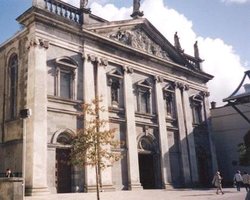Waterford
|
|
- This article is about the city in Ireland. For other uses of the name, see Waterford, disambiguation.
Template:Ireland city infobox Waterford (Irish: Port Lairge) is, historically, the capital of County Waterford in Ireland, though today the city is administered separately from the county, the latter having its seat in Dungarvan.
Founded by the Vikings in the mid-800s, Waterford was Ireland's first true city. Today Waterford is the fifth largest city in the Republic of Ireland. In April 2003 an important site combining a 5th century Iron Age and 9th century Viking settlement was discovered at Woodstown near the city.
Missing image Waterfordquay.jpg A view from The Quays: "The Three Sisters" mix near the city before flowing into the harbour. |
| Contents |
History
Main article - History of Waterford
From 795 AD, Vikings had been raiding along the coast of Ireland. Soon the Vikings over-wintered in Ireland at ships' havens called Longphorts. A longphort was established at Waterford in 853. Waterford and all the other longphorts were vacated in 902, the Vikings having being driven out by the native Irish. According to the Irish annals, the Vikings re-established themselves in Ireland at Waterford in 914 and built what would be Ireland's first city.
During the late tenth and early eleventh centuries, the rise of the Brian Boru saw Waterford and a number of other Viking ports, being firmly brought under the control of the Ua Briain dynasty. This was important as it became increasingly obvious that the control of the Viking ports, gave potential Irish High Kings, greater access to international trade, and man power.
In 1137, Diarmuid MacMorrough, king of Leinster, failed in an attempt to take Waterford. He was trying to secure the large centres in order to advance his claim for high king of Ireland. In 1170 MacMorrough allied himself with Richard de Clare, 2nd Earl of Pembroke (Strongbow); together they besieged and took Waterford after a desperate defence. This was the introduction of the Anglo-Normans into Ireland. In 1171, Henry II of England became the first English king to set foot in an Irish city, by landing with a large fleet at Waterford; he did so to ensure that Ireland became an English colony and not a rival Norman country. Waterford and Dublin were declared royal cities, and belonged to the king, not Strongbow; Dublin was declared capital of Ireland.
Throughout the medieval period, Waterford was Ireland's second city after Dublin. Waterford's great parchment book (1361-1649) represents the earliest use of the English language in Ireland for official purposes. In the 15th century Waterford repelled two pretenders to the English throne: Lambert Simnel and Perkin Warbeck. As a result, King Henry VII gave the city its motto: Urbs Intacta Manet Waterfordia (Waterford remains the untaken city).
Waterford remained a Catholic city despite the machinations of king Henry VIII, and participated in the confederation of Kilkenny which was an attempt to break away from British rule. This was ended abruptly by Oliver Cromwell, who brought the country back firmly under British rule; his nephew Ireton finally took Waterford in 1651.
The 18th century was a period of huge prosperity for Waterford. Most of the city's best architecture appeared during this time. Trading with Newfoundland brought much wealth into what was then the third largest port. In the 19th century, great industries such as glass making and ship building thrived in the city. Thomas Francis Meagher (Meagher of the sword), an Irish nationalist, made the first Irish tri-colour. He brought it back from France and it was first flown from a building on the Mall in Waterford. In the early 20th century John Redmond was MP for Waterford and leader of the Irish Parliamentary Party, which almost achieved home rule and a new parliament for Ireland.
Today
Statistics from the Central Statistics Office Census 2002 show that the population within the city is 44,594, whilst the greater urban population is 46,736. Waterford's effective population is much larger than this, with many people living in the towns and villages surrounding the city: the largest of these is Tramore (pop. 8,305) and the city borders County Kilkenny and County Waterford which have 11,459 and 18,353 respectively near the city boundaries.
Waterford is also and important education and industrial center, and like other coastal cities this has had an impact in the economy and society. The most famous product of the city is Waterford Crystal which originated when a glassmaking factory was opened in the city in 1783. Waterford Institute of Technology is a modern college located in the city and was founded in 1970, the city is also the location of several other noted colleges and schools.
The city is an important tranport center, the Iarnrod Eireann railway system has lines to Dublin, Limerick and Wexford. Several important roads in Ireland meet at Waterford, the N9 road is the main road to Dublin (via the N7 road) and also passes Kilkenny, Carlow, and Kildare, among others.
Waterford Airport and the Port of Waterford are two important infrastructural sites in presenting the city as a regional city and center.
See also
- The Three Sisters: The River Barrow, River Nore and River Suir
- Blaa, a doughy, white bread roll peculiar to Waterford City
- Waterford Airport
- Woodstown - Early Viking Settlement discovered near Waterford in 2003, on the banks of the River Suir.
External link
- Official site - Waterford City Council (http://www.waterfordcity.ie)
| Cities in Ireland |
| Republic of Ireland: Dublin | Cork | Limerick | Galway | Waterford | Kilkenny |
| Northern Ireland: Belfast | Derry | Armagh | Newry | Lisburn |

